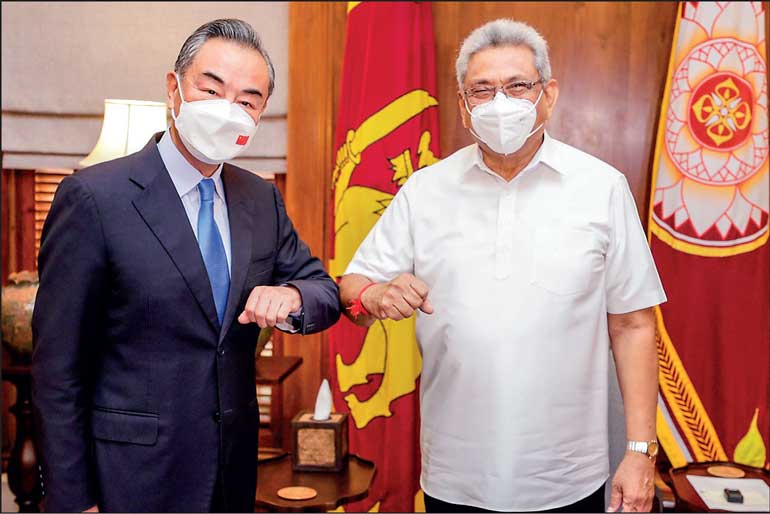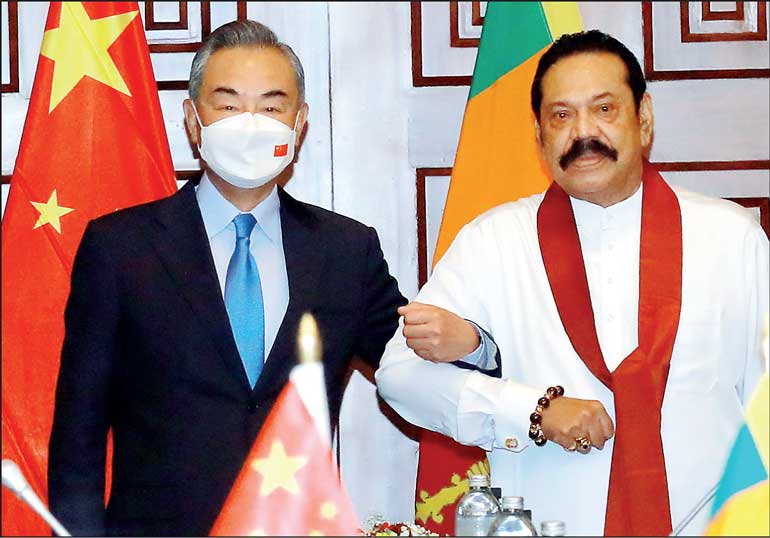Monday Apr 21, 2025
Monday Apr 21, 2025
Wednesday, 12 January 2022 00:00 - - {{hitsCtrl.values.hits}}

Chinese Foreign Minister Wang Yi and President Gotabaya Rajapaksa gesture COVID-era greeting during their meeting on Sunday in Colombo

Chinese Foreign Minister Wang Yi locks his arm with Prime Minister Mahinda Rajapaksa showing great affection to Sri Lanka’s senior statesman during their meeting on Sunday in Colombo
 Sri Lanka was the last stop on Chinese Foreign Minister Wang Yi’s packed tour of African and Asian countries in January 2022. During his visit on 9 and 10 January to mark the 65th anniversary of diplomatic relations between the two countries, Minister Wang Yi met President Gotabaya Rajapaksa and his brother Prime Minister Mahinda Rajapaksa. The high-level visit came at a time of economic uncertainties with Sri Lanka in the throes of an economic crisis and China facing a slowing economy.
Sri Lanka was the last stop on Chinese Foreign Minister Wang Yi’s packed tour of African and Asian countries in January 2022. During his visit on 9 and 10 January to mark the 65th anniversary of diplomatic relations between the two countries, Minister Wang Yi met President Gotabaya Rajapaksa and his brother Prime Minister Mahinda Rajapaksa. The high-level visit came at a time of economic uncertainties with Sri Lanka in the throes of an economic crisis and China facing a slowing economy.
A rapidly spreading Omicron virus poses additional challenges. Several issues are being debated in policy and diplomatic circles in Sri Lanka following Minister Wang Yi’s visit: What is the state of Sri Lanka economy? Will China up its assistance? What are Sri Lanka’s policy choices?
Even before the pandemic, the Sri Lankan economy was experiencing macroeconomic stress as indicated by slowing growth, large fiscal and balance of payments deficits and high external debt. The COVID-19 pandemic and the containment measures tipped the economy over the edge with growth slipping to -3.6% in 2020. Despite the toll of the pandemic, signs of an economic recovery during the first nine months of 2021 point to possible growth of 3-4% in 2021. However, dark clouds of downside risks hover over the economy in 2022 including a spreading Omicron virus, a worsening external debt position, rising inflation, social tensions and waning business confidence. The COVID economic crisis has setback Sri Lanka’s enviable social progress with at least an additional half a million people in urban areas and the informal sector becoming ‘new poor’. Women have felt heightened pressures during the pandemic from balancing the demands of work-related tasks with household chores and home schooling of children. This caused exhaustion and mental health issues, leading to some women leaving the workforce. An added challenge is that women seem more at risk of losing their jobs than men with female unemployment rates rising. It will take some time even with the right policies to reach pre-pandemic levels of social progress and gender equality.
The pandemic has significantly worsened Sri Lanka’s debt problem. Public expenditure fell during 2020-2021 as the Government scrambled to put in place measures to mitigate the reduction in economic activities while revenue generation fell to historic lows due to the economic contraction, job losses and previous income tax cuts. The fiscal deficit has steeply risen. The country’s unfavourable debt dynamics reflects persistent fiscal and current account deficits, notable currency depreciation, the costs of a 30-year civil conflict that ended in 2009, lacklustre post-conflict growth and a graduation from grant aid to foreign commercial borrowing.
Increasing concerns about debt-servicing capability have led to international credit ratings agencies downgrading Sri Lanka’s ratings, shutting off access to international bond markets, foreign capital outflows and pressures on the currency. Sri Lanka’s external debt reached $ 49.2 billion in December 2020 with substantial debt repayments of $ 4-5 billion a year required between 2022-26 backed by dangerously low foreign exchange reserves.
China and Sri Lanka have enjoyed warm diplomatic ties since Sri Lanka first recognised China in 1950, supporting China’s accession to the United Nations and signing a rubber-rice barter deal in 1952. More recently, China’s global ascent has moved its diplomatic relations with Sri Lanka in a more commercial direction.
The Chinese debt trap remains controversial. Since the early 2000s, China has become a leading provider of commercial loans to Sri Lanka for infrastructure projects including the Hambantota Port. There are claims that by accepting such loans Sri Lanka is now stuck in a ‘debt trap‘. But Sri Lanka is not in a Chinese debt trap. Much of Sri Lanka’s external public debt is owed to capital markets and that owed to China amounted to about 10% of GDP in 2020.
During the high-level talks in January, Sri Lanka reportedly requested China to restructure the debt repayments and a concessionary credit facility for imports. This has created a dilemma for China; it does not want to lose Sri Lanka’s friendship or commercial opportunities but equally is not keen to unilaterally grant Sri Lanka moratoria or debt restructuring which would serve as an example for other debt distressed developing countries to emulate. China worries that this would create a precedent that may lead to open ended commitments to respond to a number of countries which have received large amounts of Chinese loans which are now under some degree of debt distress. Thus, it is unclear whether China will agree to Sri Lanka’s request.
In public the Government has ruled out going to the IMF for assistance worried that IMF demands for austerity policies (e.g. a floating exchange rate, higher taxes, public expenditure cuts and removal of food and fuel subsidies) would be politically unpopular. Instead, it has opted for a raft of home-grown remedies including easing of monetary policy, import restrictions, exchange controls, leasing of state land to investors and a tourism and export push. The limits of these policies and the spread of Omicron suggest the need for urgent measures to tackle Sri Lanka’s economic crisis. Three concrete steps are involved.
First, a national conference involving the major political parties should be convened to forge a political consensus on the scale of economic crisis and the implications of policy choices. Second, a team of domestic experts should be tasked with developing a comprehensive structural reform programme to stabilise the economy, mitigate the hardship on the people, deregulate the economy and green the economy. Drawing on existing work by think tanks can be helpful. Third, Sri Lanka should start talks with the IMF on a program of debt restructuring and financial assistance. There is a mounting risk that time is running out to deal with these challenges in an orderly manner.
Rather than entertaining a bilateral approach to rescuing Sri Lanka, China can usefully add its powerful voice to calls for Sri Lanka to seek IMF assistance and channel technical assistance funds through the World Bank to support work on a structural reform program for Sri Lanka.
(Dr. Ganeshan Wignaraja is a Non-Resident Fellow at the Institute of South Asian Studies of the National University of Singapore. The views expressed are solely those of the author.)
Discover Kapruka, the leading online shopping platform in Sri Lanka, where you can conveniently send Gifts and Flowers to your loved ones for any event including Valentine ’s Day. Explore a wide range of popular Shopping Categories on Kapruka, including Toys, Groceries, Electronics, Birthday Cakes, Fruits, Chocolates, Flower Bouquets, Clothing, Watches, Lingerie, Gift Sets and Jewellery. Also if you’re interested in selling with Kapruka, Partner Central by Kapruka is the best solution to start with. Moreover, through Kapruka Global Shop, you can also enjoy the convenience of purchasing products from renowned platforms like Amazon and eBay and have them delivered to Sri Lanka.
Discover Kapruka, the leading online shopping platform in Sri Lanka, where you can conveniently send Gifts and Flowers to your loved ones for any event including Valentine ’s Day. Explore a wide range of popular Shopping Categories on Kapruka, including Toys, Groceries, Electronics, Birthday Cakes, Fruits, Chocolates, Flower Bouquets, Clothing, Watches, Lingerie, Gift Sets and Jewellery. Also if you’re interested in selling with Kapruka, Partner Central by Kapruka is the best solution to start with. Moreover, through Kapruka Global Shop, you can also enjoy the convenience of purchasing products from renowned platforms like Amazon and eBay and have them delivered to Sri Lanka.